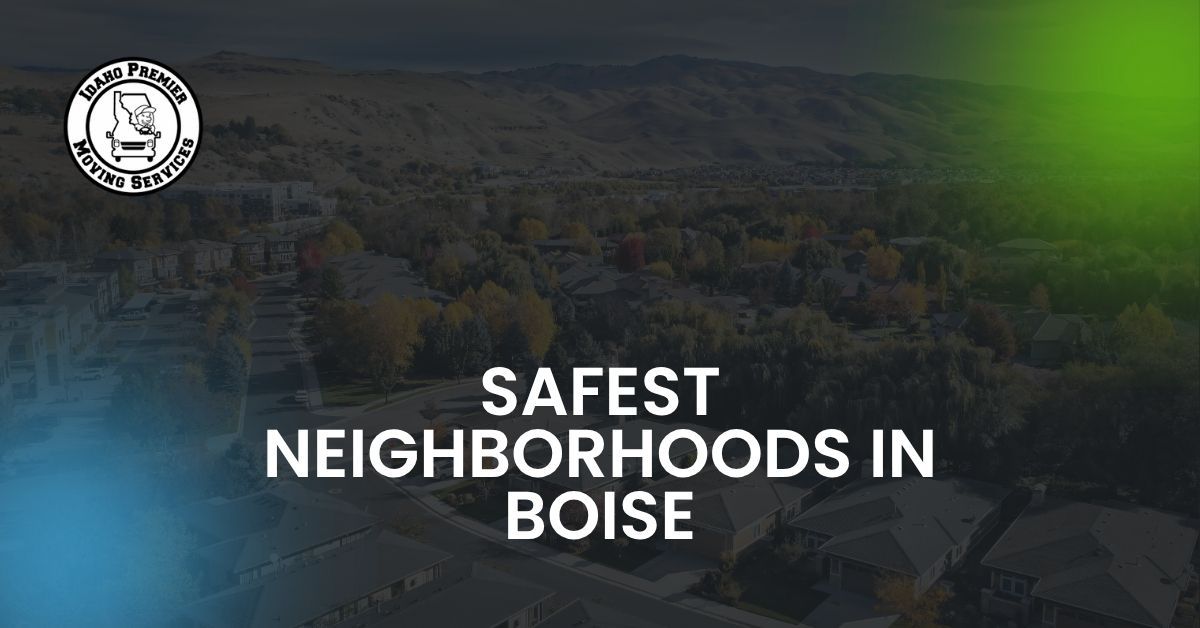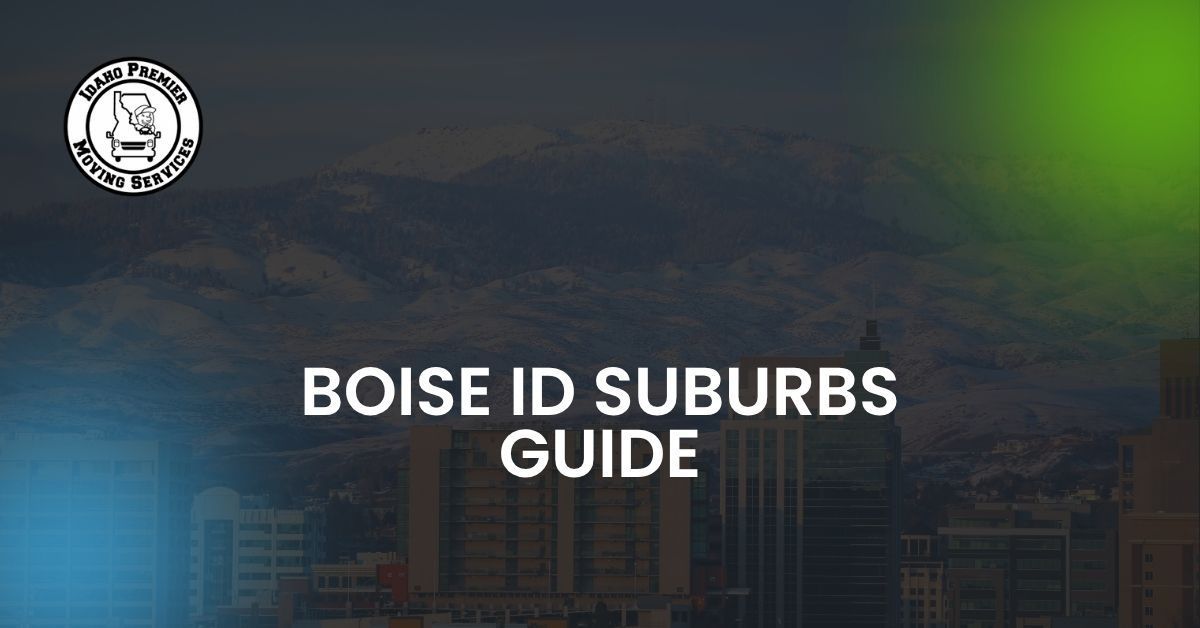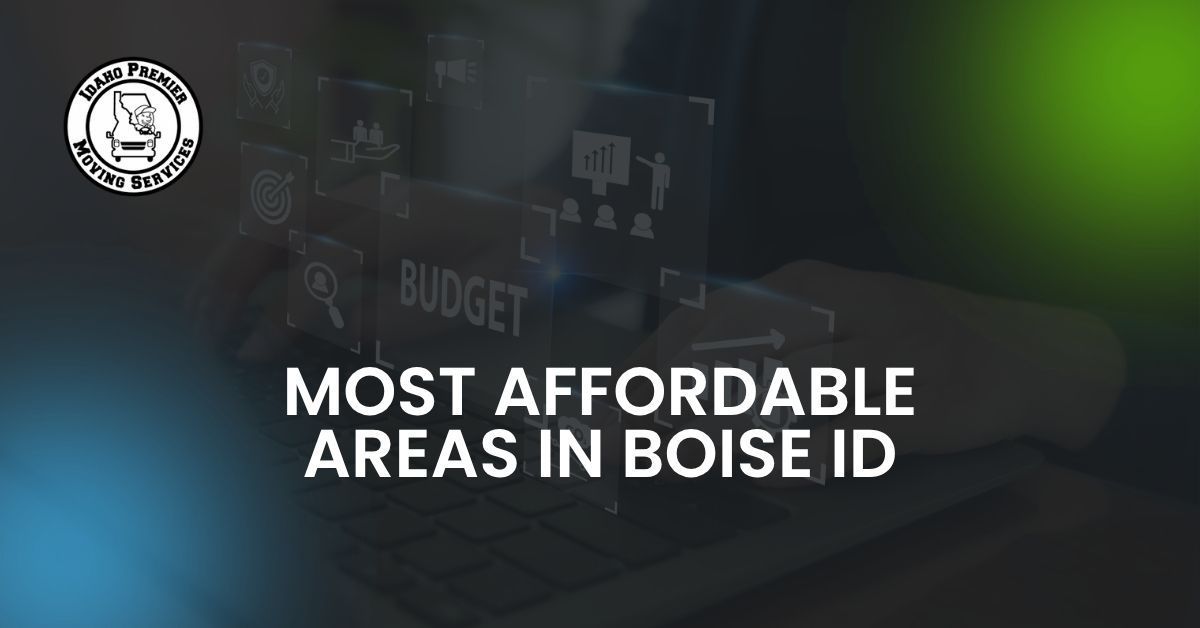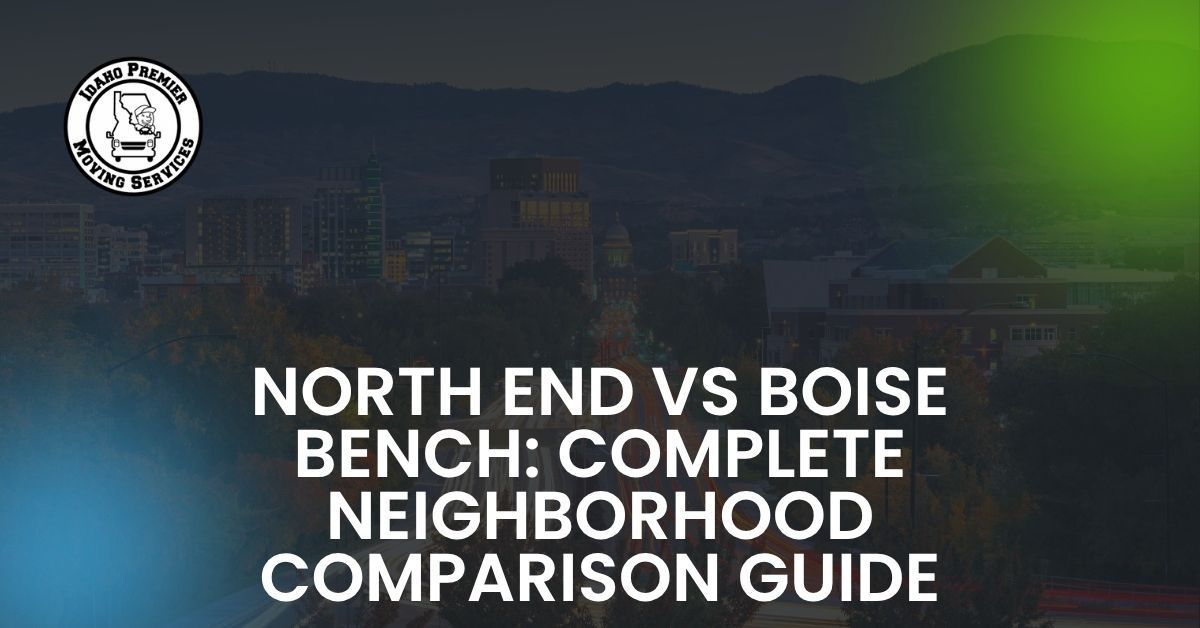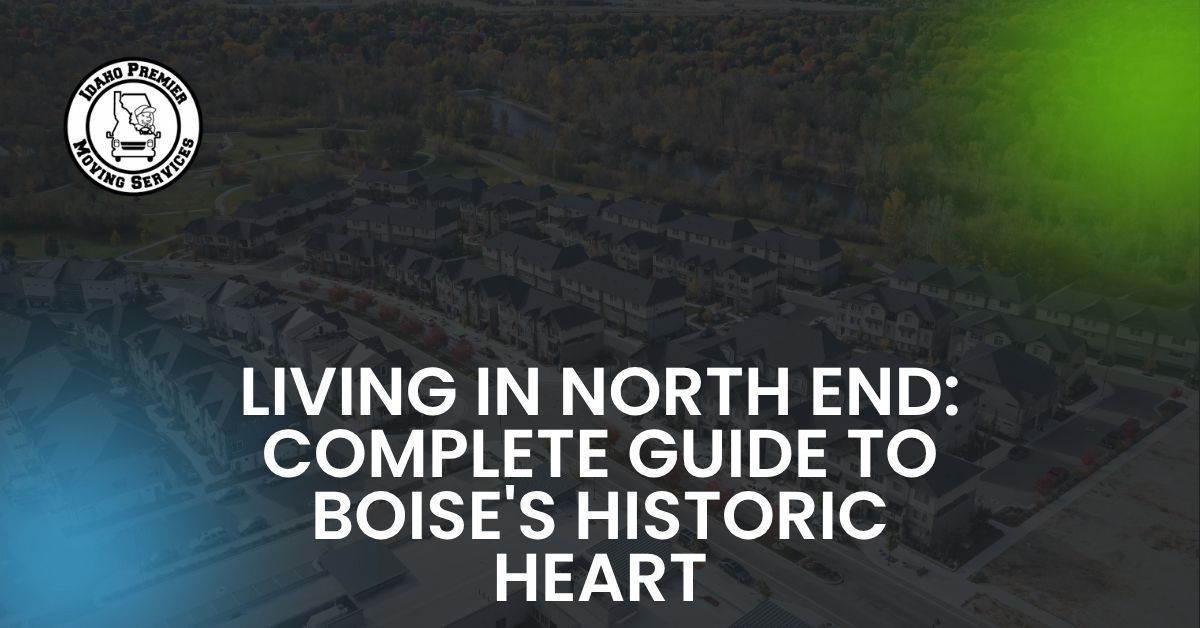Boise Neighborhoods Your Complete Guide to Finding the Right Area
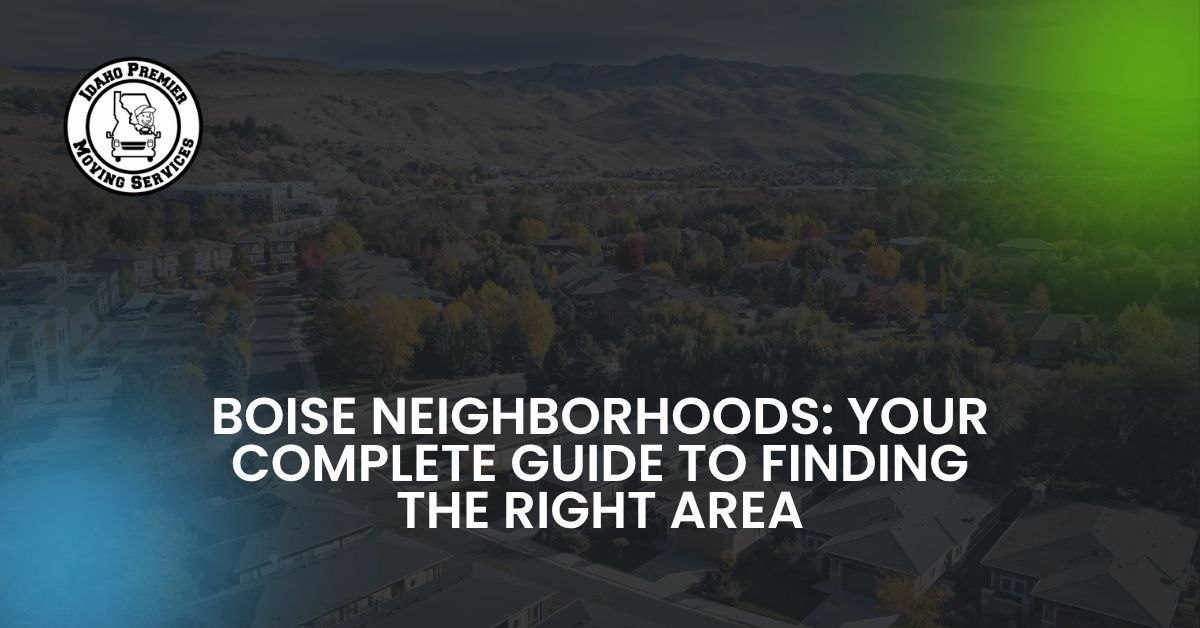
We know that planning a move is both exciting and overwhelming—especially when you're trying to figure out not just if you should move to Boise, but where in Boise you should call home. You're scrolling through listings online, seeing neighborhood names like North End, Boise Bench, Southeast Boise, and Downtown, and wondering what each area is really like beyond the property photos and descriptions.
That's exactly why we created this comprehensive guide to Boise neighborhoods. As your trusted local partner at Idaho Premier Moving, we've helped hundreds of families navigate this exact decision. We've moved young professionals into downtown lofts near 8th Street, helped families settle into spacious homes in the Boise Bench area, and assisted outdoor enthusiasts finding their perfect foothill property with trail access—always with the professionalism and reliability that defines premier moving service.
Boise isn't a small town with just a few streets to choose from. This growing city of approximately 240,000 residents (metro area around 750,000) offers diverse neighborhoods ranging from historic districts with century-old homes to modern suburban developments to mountain-adjacent communities with stunning views. Whether you're drawn to walkable urban living, family-oriented suburbs, or immediate access to outdoor recreation, you'll find options here.
In this guide, we'll walk you through the key areas in Boise, giving you the real details you need to make an informed decision. We'll cover what makes each neighborhood special, who tends to thrive there, and what daily life actually looks like—from where you'll grab your morning coffee to which trails you'll hike to how your commute will look if you're working at Micron Technology or downtown.
Understanding Boise's Neighborhood Layout
Before we dive into specific neighborhoods in Boise, it helps to understand how this city is organized and what defines its different areas.
Boise sits in the Treasure Valley along the Boise River at the base of the Boise Foothills. The river and foothills create natural landmarks that shape how residents describe locations—north of the river versus south, close to the foothills versus the valley floor, east versus west.
State Street runs east-west through the heart of Boise, serving as a major dividing line and reference point. Capitol Boulevard and Broadway Avenue run north-south, with Capitol Boulevard particularly important as it connects downtown to the interstate.
Interstate 84 cuts through the southern portion of the city, providing the primary route connecting Boise to points west (Oregon) and east (through Idaho). Boise River Greenbelt—the 25-mile pathway following the river—serves as both recreation corridor and geographical reference, with neighborhoods often described by their relationship to the Greenbelt.
The Boise Foothills rise immediately north and northeast of the city, creating that dramatic backdrop of mountains and brown hills that define Boise's visual character. Neighborhoods climb into these foothills, with elevation bringing views, wildfire considerations, and that mountain-living aesthetic.
Downtown Boise centers around 8th Street and Capitol Boulevard, with the Idaho State Capitol and business district forming the urban core. The BoDo (Boise Downtown) district represents newer mixed-use development bringing residential density downtown.
Most of Boise developed outward from downtown, with older neighborhoods close to the center featuring tree-lined streets and historic character, while newer development spreads east, southeast, and west with more contemporary suburban patterns.
North End: Boise's Most Prestigious Neighborhood
What Defines This Area
The North End represents Boise's most established and desirable neighborhood, stretching north from downtown roughly between 13th Street and the foothills, and from Hill Road east to Bogus Basin Road. This is where Boise's character shines brightest—tree-lined streets with mature canopy creating genuine urban forest, historic homes from the early 1900s showcasing Craftsman, Tudor, and Victorian architecture, and that walkable neighborhood feel increasingly rare in Western cities.
Hyde Park serves as the North End's commercial heart—a small district along 13th Street featuring Hyde Perk Coffeehouse, Parc Bistro, The Wok, Hyde Park Books, and local businesses creating genuine neighborhood center where residents walk for coffee, groceries at Hyde Park Market, and community connection.
Camel's Back Park provides immediate foothill access with playground, green space, and trailheads connecting to the extensive Ridge to Rivers trail system. Residents walk to the park from surrounding blocks, bike up the hill, and treat the foothills as their backyard.
Housing in North End ranges from charming bungalows at 1,200 square feet to substantial renovated homes exceeding 3,000 square feet. Most properties date from 1900-1950, with architectural character reflecting those eras. Many have been renovated with modern systems and updated interiors while maintaining period exteriors. Lots are typically 6,000-10,000 square feet—modest by suburban standards but generous for walkable urban neighborhoods.
Who Thrives Here
North End attracts professionals, creatives, academics affiliated with Boise State University, and longtime Boiseans who value character and community over space and newness. You'll meet attorneys, professors, business owners, artists, and people who specifically chose Boise for its outdoor lifestyle and want to live where that's most accessible.
The demographic skews slightly older and more established—many residents in their 40s-60s, though young professionals and families certainly live here. What unites residents is appreciation for walkability, historic character, outdoor access, and community connection.
The culture emphasizes neighborhood identity and preservation. The North End Neighborhood Association actively works to maintain character and address issues. Residents know their neighbors, frequent local businesses, and participate in community life. There's a genuine neighborhood feel where people wave while walking, gather at Camel's Back Park, and treat the area as a true community rather than just where they sleep.
For those exploring the walkable neighborhoods in Boise, North End delivers on this criterion better than anywhere else in the city. You can walk to Hyde Park for coffee and groceries, reach downtown in 15-20 minutes on foot, and access countless trails from your doorstep.
The Practical Details
North End pricing typically ranges from $450,000 to over $1 million depending on size, condition, and exact location. Homes closest to Hyde Park and with the best foothill access command premiums. The pricing reflects decades of sustained desirability—this has been Boise's most prestigious address for generations.
Boise School District serves North End with Roosevelt Elementary School being the assigned elementary school for much of the area. The school benefits from engaged parent community and typically strong performance. Families should verify specific assignments as boundaries can be complex in this older neighborhood.
Parking can be challenging—many historic homes have single-car garages or carports, and street parking fills on popular blocks. This trade-off comes with the walkable urban character that residents specifically value.
The location provides excellent access to downtown employment (5-10 minutes), Boise State University (10 minutes), and immediate foothill recreation. Commutes to Micron Technology or other west Boise employers take 20-30 minutes.
For comprehensive details about North End's history, specific sub-neighborhoods, daily lifestyle, and whether it matches your priorities, our complete guide Living in North End: Complete Guide provides in-depth coverage of Boise's most prestigious neighborhood.
Downtown and BoDo: Urban Living in Boise
What Defines This Area
Downtown Boise along Capitol Boulevard, 8th Street, and surrounding blocks offers Boise's most urban living experience. High-rise condos, converted loft apartments in historic buildings, and townhomes put residents within walking distance of Boise Centre convention center, The Egyptian Theatre, state government offices, law firms, and urban services.
The BoDo (Boise Downtown) district represents newer mixed-use development transforming former industrial areas into contemporary urban neighborhoods. Modern apartment buildings with ground-floor retail, restaurants like Fork, Chandler's Steakhouse, Bittercreek Alehouse, and businesses create that urban energy Boise historically lacked.
Basque Block along Grove Street celebrates Boise's unique Basque heritage with restaurants including Bar Gernika, Leku Ona, and the Basque Museum & Cultural Center—representing a community and cultural tradition uncommon outside the Basque Country and scattered diaspora communities.
8th Street serves as downtown's main spine with pedestrian-friendly blocks, outdoor dining, Bardenay distillery (Idaho's first), and mix of local and regional businesses. Summer brings Capital City Public Market and outdoor events activating public spaces.
Housing downtown ranges from studio apartments at $1,000-1,400/month to luxury penthouses exceeding $1 million. The inventory includes older buildings converted to condos, new construction high-rises, and townhomes in the most urban sections.
Who Thrives Here
Downtown attracts young professionals working for state government or downtown firms, empty-nesters who sold larger homes and want urban convenience, and those who specifically value walkability and city energy over space and yards.
The demographic skews younger in rental apartments (20s-30s) and slightly older in owned condos (30s-50s and retirees). What unites residents is valuing urban lifestyle, not wanting car-dependent suburban living, and appreciating the convenience of walking to restaurants, culture, and services.
The culture emphasizes spontaneity and urban rhythms—grabbing dinner at Barbacoa Grill without planning, walking to The Egyptian Theatre for shows, meeting friends at Bittercreek after work, and embracing that city lifestyle. It's not where families with three kids typically choose, but for individuals and couples wanting urban experience, downtown delivers.
For those specifically interested in urban-style living and career-focused environments, our guide to young professional areas in Boise explores downtown and other neighborhoods attracting career-oriented residents.
The Practical Details
Downtown rental apartments typically range from $1,000-2,400/month depending on size and building. Owned condos start around $250,000 for smaller units and can exceed $800,000 for luxury properties with views.
HOA or condo fees cover building maintenance, amenities, and sometimes utilities, typically running $300-500+ monthly for owned properties. This creates substantial ongoing costs beyond mortgage that must be factored into budgets.
Boise School District schools serve downtown, though the area's demographic means fewer school-age children compared to suburban neighborhoods. Families with kids typically choose downtown specifically for the lifestyle despite less traditional family environment.
Parking challenges vary by property—some buildings include garage parking, others provide limited spaces, and street parking during events fills quickly. This urban reality contrasts with typical Boise neighborhoods where parking is abundant.
The location provides immediate walk or bike access to employment downtown, state government, and Boise State University. Commutes to Micron or west Boise employers take 20-30 minutes via Interstate 84.
East Boise: Accessible Urban-Adjacent Living
What Defines This Area
East Boise encompasses neighborhoods east of downtown roughly from Capitol Boulevard to Cole Road, extending from the river south to Warm Springs Avenue and beyond. This diverse area includes everything from student rentals near Boise State University to family neighborhoods to historic pockets with character homes.
Julia Davis Park anchors the area with its 89 acres including Zoo Boise, Boise Art Museum, Idaho Black History Museum, Idaho Historical Museum, and extensive green space along the Greenbelt. The park serves as a community gathering spot and destination for families throughout Boise.
The neighborhoods closest to downtown and Boise State include many rentals housing students and young professionals, creating transient character in some blocks. Moving farther east and south brings more stable family neighborhoods with owner-occupied homes and established residents.
Housing ranges from 1920s-40s bungalows to 1960s-70s ranches to some newer infill construction. Most properties fall in the 1,200-2,000 square foot range on modest lots, reflecting the era when neighborhoods prioritized affordability and practicality over luxury and space.
Who Thrives Here
East Boise attracts diverse demographics—students attending Boise State (particularly in areas closest to campus), young professionals buying their first homes, families seeking established neighborhoods at moderate prices, and longtime Boiseans who've lived here for decades.
The area's diversity creates varied neighborhood character. Some blocks feel like university housing with rental turnover and student activity. Others feature stable family neighborhoods where residents have lived for years. This variation means researching specific streets and blocks matters more than judging all of East Boise as monolithic.
What unites many residents is valuing proximity to downtown, Greenbelt access, and affordability compared to North End or foothills. East Boise provides accessible homeownership in established Boise neighborhoods without the premiums of more prestigious areas.
The Practical Details
East Boise pricing typically ranges from $350,000 to $600,000 depending on size, condition, and exact location. Homes closest to Julia Davis Park and with character command higher prices, while areas with more rental activity offer more affordable entry points.
Boise School District serves East Boise with various schools depending on exact location. Families should research specific campus assignments and performance, as quality varies across the district.
The location provides excellent access to downtown employment (5-15 minutes), Boise State University (immediate for campus-adjacent areas), and the Greenbelt for recreation and commuting. Commutes to west Boise employers take 20-30 minutes.
Crime rates vary by specific neighborhood—areas closest to downtown and with higher rental concentrations see more property crime, while established family neighborhoods maintain low rates typical of Boise generally. Prospective residents should research specific blocks and visit at different times.
For families seeking established neighborhoods at moderate prices, East Boise offers options worth exploring, particularly the family-oriented sections south of Warm Springs Avenue and away from heaviest student concentrations.
Southeast Boise: Suburban Family Living
What Defines This Area
Southeast Boise encompasses the area roughly east of Cole Road, south of Warm Springs Avenue, extending toward the Ada County line. This section includes a mix of established neighborhoods from the 1970s-90s and newer developments, creating variety in housing styles and price points.
Barber Park provides major recreation access with its position along the Boise River as the primary put-in point for the famous summer float down the river to Ann Morrison Park. The park features playgrounds, picnic areas, and serves as outdoor recreation hub.
The neighborhoods emphasize suburban living—single-family homes with yards, quiet streets with minimal through-traffic, parks scattered throughout providing local recreation, and that car-dependent lifestyle typical of American suburbs. While not walkable to shopping or services, residents trade this for space, yards, and established neighborhoods.
Housing ranges from 1,500 to 3,000+ square feet, mostly built from 1970s through present, with styles including ranches, split-levels, and two-story family homes. Lot sizes typically provide 7,000-10,000 square feet—room for play structures, gardens, and outdoor living while maintaining suburban density.
Who Thrives Here
Southeast Boise attracts families with children seeking good schools, safe streets, and that suburban lifestyle with yards and neighborhood parks. You'll meet dual-income families, professionals working throughout the valley, and parents who prioritize accessibility to outdoor recreation (Barber Park, easy access to foothills) alongside family-friendly neighborhoods.
The demographic centers on families with school-age children, though established residents who raised families here often remain as empty-nesters appreciating the familiar neighborhood and convenient location.
The culture emphasizes family activities and outdoor recreation. Summer weekends bring families to Barber Park for river access, youth sports leagues use neighborhood fields, and families gather at community parks. It's solidly middle-class suburban living focused on children's activities and enjoying Boise's outdoor assets.
For families specifically evaluating neighborhoods based on schools, safety, and family amenities, our comprehensive guide to the best family neighborhoods in Boise provides detailed comparisons of school quality, park access, and family-specific factors across all areas.
The Practical Details
Southeast Boise pricing typically ranges from $400,000 to $650,000 for most family-sized homes, positioning it as accessible to middle-class families while requiring substantial dual incomes or single high earners.
Boise School District serves most of Southeast Boise, with schools including Borah High School serving many areas. School quality varies by campus—families should research specific assignments and visit schools to assess fit.
The location provides good access to Interstate 84 for commuting west to Micron or other employers, typically 20-30 minutes. Downtown Boise sits 15-20 minutes west via major arterials.
Shopping and services require driving to commercial corridors along Cole Road, Broadway, or toward the Boise Towne Square area. The purely residential character means daily errands involve short drives rather than walking.
Safety in Southeast Boise is good, with low crime rates typical of family-oriented suburban neighborhoods. Residents feel comfortable with children playing outside and that general sense of security suburban families seek.
Boise Bench: Affordable Character and Diversity
What Defines This Area
Boise Bench refers to the plateau area south of downtown Boise, roughly from Capitol Boulevard west to Cole Road, and from Warm Springs Avenue south to Overland Road. The area sits elevated above downtown on a geologic bench, giving the neighborhood its name.
The housing stock primarily consists of modest homes from the 1950s-70s, predominantly ranches and split-levels reflecting mid-century construction when affordability and practicality dominated design. Most homes range from 1,000 to 1,800 square feet on standard suburban lots of 6,000-8,000 square feet.
The character is distinctly working-class to middle-class, with diversity in both demographics and property conditions. Some blocks feature well-maintained homes with proud owners, while others show deferred maintenance and rental properties. This variation creates a patchwork where specific streets matter more than broad generalizations.
Veterans Memorial Parkway (the freeway connecting Interstate 84 to State Street) cuts through the Bench, providing convenient highway access but also creating noise and dividing neighborhoods. Boise Towne Square mall sits on the Bench's western edge, providing shopping convenience.
Who Thrives Here
Boise Bench attracts first-time homebuyers, working families, recent immigrants building their first equity, military families stationed at the Gowen Field Air National Guard Base, and anyone prioritizing affordable homeownership over prestige addresses.
The demographic is genuinely diverse—reflecting various ethnicities, income levels, and life stages. You'll meet families who bought here decades ago and remained, young couples buying their first homes, veterans, and service workers building middle-class lives.
The culture emphasizes practicality, community, and accessibility. Residents here aren't seeking prestige—they're building equity, raising families, and appreciating Boise's quality of life at accessible price points. The area lacks the cohesive identity of North End or suburban uniformity of newer developments, but that creates authentic diversity increasingly rare in gentrifying cities.
For those specifically seeking accessible entry points to Boise homeownership, our guide to the most affordable areas in Boise highlights which neighborhoods provide the best value without sacrificing safety or access to amenities.
The Practical Details
Boise Bench pricing typically ranges from $300,000 to $500,000, representing some of Boise's most accessible homeownership for those willing to accept modest homes that may need updates. This makes it particularly attractive to first-time buyers priced out of North End or foothills.
Boise School District serves the Bench with various schools. School quality varies significantly by campus—some schools on the Bench perform well while others face challenges serving economically diverse populations. Families must research specific assignments carefully.
The location provides excellent highway access via Veterans Memorial Parkway to Interstate 84, making commutes to any part of the valley relatively quick—typically 15-25 minutes to most destinations.
Shopping is immediately convenient with Boise Towne Square, Fred Meyer, Target, and countless other retailers right on the Bench or just minutes away. For families prioritizing shopping convenience and highway access, the Bench delivers.
Crime rates are moderate—higher than North End or foothill neighborhoods but manageable for an urban working-class area. Standard urban precautions apply, though violent crime remains relatively rare. Prospective residents should research specific neighborhoods and visit at different times to assess comfort levels.
For a detailed comparison of how Boise Bench stacks up against more established neighborhoods, our analysis North End vs Boise Bench: Comparison breaks down the trade-offs between character/prestige and affordability/accessibility.
West Boise and Meridian: Growth and Suburban Development
What Defines These Areas
West Boise and Meridian (technically a separate city but functionally connected to Boise) represent the Treasure Valley's primary growth corridor, with newer subdivisions, master-planned communities, and contemporary suburban development dominating the landscape.
The Village at Meridian serves as a lifestyle center with shopping including Target, Trader Joe's, Whole Foods, dining from BJ's Restaurant to The Cheesecake Factory to local options, and entertainment creating suburban commercial hub. The outdoor retail format with wide sidewalks and gathering spaces attempts to recreate small-town main street feel in suburban context.
The neighborhoods emphasize new construction from major builders, with homes typically built from 2000-present featuring open floor plans, contemporary design, and modern systems. Most properties range from 1,800 to 3,500 square feet with 3-5 bedrooms sized for families.
The area continues expanding northward and westward as farmland converts to subdivisions, shopping centers, and services supporting the growing population. This means some areas feel fully established while others are literally under construction.
Who Thrives Here
West Boise and Meridian attract families seeking new construction, modern amenities, and that complete suburban package with good schools, safe streets, and convenient shopping. Many are relocating from other states—California, Washington, Oregon—drawn by Idaho's growth and conservative politics or simply following job opportunities.
The demographic centers on young families and established professionals with children, typically dual-income households. Many work in Boise's tech sector, healthcare, or other professional fields providing incomes to afford the newer construction premiums.
The culture emphasizes family activities, suburban convenience, and enjoying amenities. This is where families spend Saturday mornings at youth sports, afternoons at The Village at Meridian, and evenings in neighborhood parks—very much that contemporary American suburban lifestyle.
The Practical Details
West Boise and Meridian pricing typically ranges from $400,000 to $750,000+ for most family homes, with newer construction commanding premiums over Boise's established neighborhoods. The trade-off is everything is new, nothing needs immediate renovation, and warranties protect against defects.
Meridian School District serves most of Meridian with newer schools built to accommodate growth. The district has invested heavily in facilities and generally maintains solid performance. West Ada School District serves areas farther west including Eagle.
The location means longer commutes for those working in downtown Boise or on the east side—figure 25-35 minutes to downtown depending on exact locations and traffic. However, for those working at companies in west Boise or Micron Technology, commutes are short.
Shopping and services are abundant with The Village at Meridian, Costco, countless retailers, restaurants, and services making daily life highly convenient. This area prioritizes accessibility and convenience, delivering on those priorities effectively.
For those curious about communities beyond Boise city limits that still feel part of the metro area, our Boise suburbs guide examines Meridian, Eagle, and other nearby cities worth considering.
Foothills Neighborhoods: Mountain Living in the City
What Defines These Areas
The Foothills neighborhoods along Bogus Basin Road, Shaw Mountain Road, and throughout the hills north and northeast of Boise provide mountain living within city limits. These aren't suburbs—they're homes carved into mountainsides with stunning valley views, immediate trail access, and wildlife as neighbors.
Bogus Basin ski area sits 16 miles up Bogus Basin Road, making these neighborhoods particularly attractive to skiers who can reach the mountain in 20-30 minutes. The road to Bogus Basin becomes a scenic drive and commute route rather than just highway.
Housing ranges from modest mountain cabins to multi-million dollar custom homes with floor-to-ceiling windows capturing valley and mountain views. Most properties sit on larger lots (often 1+ acres) with natural vegetation and terrain that limits development density.
The fire danger represents real consideration—wildfires threaten foothill neighborhoods regularly, and homeowners insurance costs reflect this risk. The Boise Fire Department and residents must maintain defensible space around homes, and evacuation plans become part of life in fire-prone summers.
Who Thrives Here
Foothills neighborhoods attract outdoor enthusiasts, successful professionals and entrepreneurs who can afford premium properties, and those who specifically moved to Boise for the mountain lifestyle and want it at their doorstep. You'll meet serious mountain bikers, backcountry skiers, runners, and people who hike daily rather than occasionally.
The demographic includes established professionals (40s-60s) who've achieved career success and want their home to reflect their outdoor priorities, young tech workers earning substantial incomes, and retirees who sold properties elsewhere and chose foothills specifically for the lifestyle.
The culture emphasizes outdoor recreation and environmental connection. Residents run and bike from their driveways, know trail systems intimately, and embrace the wildfire risk and winter driving challenges as acceptable trade-offs for the lifestyle. This isn't for everyone—it requires genuine commitment to mountain living.
For those seeking premium properties with views and immediate outdoor access, our guide to luxury neighborhoods in Boise explores foothills communities and other upscale areas throughout the city.
The Practical Details
Foothills pricing ranges from $450,000 to well over $2 million depending on location, views, and property quality. The dramatic valley views command substantial premiums, and waterfront properties or those with especially desirable characteristics can exceed typical pricing.
Boise School District serves foothills neighborhoods with various school assignments requiring buses or parent drop-off given the distance from schools. The commute to schools adds complexity for families with children.
Winter weather affects foothills significantly—Bogus Basin Road and other routes see snow, ice, and challenging conditions requiring 4WD vehicles and winter driving skills. Some properties become difficult to access during storms.
The commute to valley employment takes longer from foothills—figure 20-30 minutes to downtown Boise depending on exact location, with winter conditions adding time. For those working remotely or with flexible schedules, this matters less.
Fire insurance costs more in foothills, and some properties face difficulty obtaining coverage from traditional carriers, requiring specialized high-risk policies at premium prices. This is real consideration for budgeting.
Making Your Decision: Choosing Your Boise Neighborhood
Every neighborhood in Boise we've covered offers something valuable—the question is which combination of features, lifestyle, and trade-offs aligns with your specific priorities and budget.
If character, walkability, and prestigious address top your list, North End delivers Boise's most established neighborhood with foothill access, though at premium pricing reflecting sustained desirability.
For urban lifestyle and downtown walkability, Downtown/BoDo provides city living rare in Western metros, though with trade-offs in space and parking typical of urban environments.
Families prioritizing good schools, safe streets, and suburban comfort should explore Southeast Boise and West Boise/Meridian, where family-oriented neighborhoods and modern construction dominate.
Those seeking affordability and authentic diversity should consider Boise Bench and East Boise, where accessible homeownership and established neighborhoods provide value if you accept modest homes and varied neighborhood character.
For mountain living and immediate outdoor access, Foothills neighborhoods deliver lifestyle unavailable elsewhere in Boise, though requiring acceptance of fire risk, winter challenges, and premium pricing.
The honest truth? You're not making a terrible mistake with any of these choices. All offer safe, livable environments with access to Boise's outdoor recreation and quality of life. The key is understanding what you're optimizing for—character vs. newness, urban vs. suburban, affordability vs. prestige, convenience vs. views.
We strongly recommend visiting neighborhoods at different times of day. Drive through on weekday mornings during rush hour. Visit on Saturday afternoons when residents are active. Stop on weekday evenings to see neighborhoods come alive after work. The right fit will become apparent through these observations.
Talk to current residents if possible. People walking dogs, working in yards, or at local coffee shops are usually happy to share perspectives. Stop at Hyde Perk in North End, grab coffee downtown, or visit neighborhood spots and strike up conversations. You'll gain insights that listings can't provide.
For comprehensive guidance on everything else Boise offers beyond just neighborhoods, explore our detailed Boise City Guide Everything You Need to Know, which covers schools, cost of living, employment, recreation, and all aspects of life in Idaho's capital city.
Moving to Your Chosen Boise Neighborhood
Once you've identified your target neighborhood, Idaho Premier Moving is ready to make your transition seamless. We've moved families into every neighborhood we've discussed—from navigating North End's narrow streets and limited parking to coordinating high-rise condo moves downtown to handling challenging foothill access with steep driveways.
Our team knows Boise intimately—which neighborhoods have difficult access requiring special equipment, when traffic is lightest for moving days, and how to efficiently navigate everything from urban downtown moves to mountain properties. As experienced local professionals, we've successfully relocated hundreds of families throughout Boise and the Treasure Valley.
We offer comprehensive moving services including:
- Professional packing and careful handling
- Efficient loading and secure transport
- Coordination for challenging access situations
- Full licensing and insurance
- Local expertise that makes your move smoother
Whether you're relocating from across the country or moving between neighborhoods within Boise, we handle the logistics professionally while you focus on settling into your new community. We're not just moving your belongings—we're helping you start your next chapter in the right Boise neighborhood for your life.
